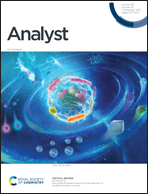A specific visual-volumetric sensor for mercury ions based on smart hydrogel†
Abstract
On the basis of the “seeing is believing” concept and the existing theory of Hg2+ coordination chemistry, for the first time, we innovatively designed and synthesized a visual-volumetric sensor platform with fluorescein and uracil functionalized polyacrylamide hydrogel. Without the aid of any complicated instruments and power sources, the sensor-enabled quantitative μM-level Hg2+ detection Hg2+ by reading graduation on a pipette with the naked eye. The sensor undergoes volumetric response and shows a wide linear response range to Hg2+ (1.0 × 10−6–5.0 × 10−5 mol L−1) with 2.8 × 10−7 mol L−1 as the detection limit. The highly selective (easily distinguished Hg2+ from other common metal ions), rapid response (∼30 min), and acceptable repeatability (RSD < 5% in all cases) demonstrated that the developed sensor is suitable for onsite practical use for the determination of Hg2+ while being low-cost, simple, and portable. The design principles of the obtained materials and the construction techniques and methods of the sensors described in our study provide a new idea for the research and development of smart materials and a series of visual-volumetric sensors for other analytes.



 Please wait while we load your content...
Please wait while we load your content...